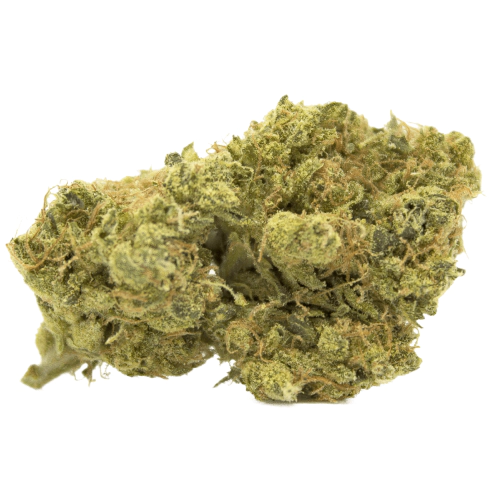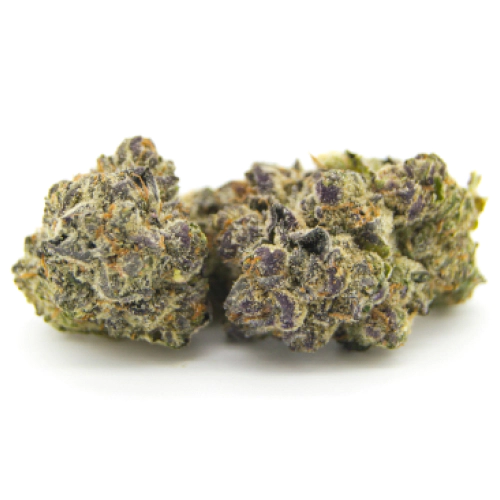THC 19.5 - 20%
CBD 0.72 - 1.3%
Effect Sleepy
Flavor Berry
Orangutan is a cross between Orange Crush and Citrus Sap with two potent mainstays, GG4 and Tangie. The buds are light green and thick, smelling of gasoline, earth, grapefruits, and oranges. With an overall THC ratio of 10%, Orangutan is considered to be a great choice for experienced users. Beginners might like selecting less potent options instead. The strain is rich in terpenes such as Linalool, Limonene, Humulene, and Carene. That explains its ability to provide a wide range of health benefits to a user.
The high is followed by an almost immediate physical relaxation accompanied by a euphoric headband sensation. The strain is known to boost one’s mood and eliminate stress. It is mostly recommended for daytime usage. Doctors often prescribe Orangutan to those patients suffering from bipolar disorder, fatigue, migraines, muscle spasms, arthritis. As the level of THC found in cannabis is high, one should be carefully measuring the amount of weed smoked. If overdosed, it might lead to dry eyes, dizziness, and low blood pressure.
Typical effects:
A typical plant height ranges from 60 to 80 inches. The flowering period takes no longer than 71 days. The growing difficulty of the Orangutan strain can be evaluated as moderate. The plant does well both indoors and outdoors.
| THC | Tetrahydrocannabinol, or THC, is a major cannabis chemical compound. It is a psychoactive element that stimulates dopamine release and induces euphoria or happiness. THC-rich strains may be helpful with such conditions as lack of appetite, chronic pains , etc. It is considered to be the primary active marijuana component. | 7.75 - 13.25% |
| CBD | Cannabidiol, or CBD, is a major compound in cannabis, which is non-psychoactive. It is also proved to counteract the side effects of the second major component THC. CBD is widely used for medicinal purposes in rubs, oils and so on. It is helpful in muscle pain cases, may treat arthritis and migraines. Even Greeks used it against pain, while Queen Victoria applied it to get rid of menstrual cramps. | 0.37 - 1.03% |
| CBC | Cannabichromene, or CBC, is a minor cannabinoid, meaning that its quantity in cannabis is quite little. Though it has the same origin as CBD and THC, it is different in functions. Without any psychoactive effects, it is an efficient cannabis compound in combating acne and depression. CBC produces analgesic, antibacterial and anti-inflammatory effects. | 0.38 - 0.54% |
| CBG | Cannabigerol, or CBG, is one of the minor cannabis compounds in adult plants. On the other hand, young ones contain a lot of this antibacterial and anti-inflammatory component. During the growth, CBG is converted into different cannabinoids, mostly THC and CBD. The compound itself increases appetite and decreases eye pressure. | 0.47 - 1.01% |
| CBN | Cannabinol, or CBN, is a trace element in cannabis that is considered to be mildly psychoactive. It appears from oxidation THC, exposed to light and heat. CBN is mostly contained in old cannabis and in traditional hashish. It is effective against insomnia, bacterial infections and appetite loss. | 0.05 - 0.27% |
| THCV | Tetrahydrocannabivarin, or THC-V, is a compound contained in cannabis in trace amounts. Even though it is close to THC molecularly, it is different in effects. This compound may be psychoactive only in large amounts. THC-V reduces blood sugar, controls appetite, stimulates bone growth, etc. African Sativa strains are the richest in THC-V. | 0.27 - 0.69% |
| Carene | Carene (also known as Delta-3 carene) is a terpene found in rosemary, lemons, pines, and cedars, offering citrusy and cypress aroma. Studies on mice showed that carene provides anti-inflammatory effects, as well as promotes bone health and chronic pain relief. | 0.37% |
| Humulene | Humulene (also known as α-humulene) is one of the major terpenes found in cannabis, contributing to woody, earthy, spicy, herbaceous, and, mainly, floral aromas of cannabis. Used in modern medicine, humulene offers anti-inflammatory, antibacterial, and appetite suppressant effects, which have been well-researched by pharmaceutical companies. | 0.05% |
| Limonene | Limonene (also known as d-limonene) is the second most common terpene in nature and the third most common terpene in cannabis. It has a powerful citrus aroma and can be found in all citruses, including lemons, oranges, grapefruits, limes, juniper, etc. Limonene is known to elevate moods and provide anxiety, depression, and stress relief. | 0.37% |
| Linalool | Linalool (also known as beta linalool, linalyl alcohol, linaloyl oxide, and p-linalool) is one of the rarest terpenes found in cannabis, mostly in small quantities. Linalool is known for its spicy and lavender aroma, bringing relaxation and calming effects. It is also said to provide anti-inflammatory and analgesic properties that can be useful for athletes. | 0.21% |
| Total terpenes content | 1.00% |
THC 19.5 - 20%
CBD 0.72 - 1.3%
Effect Sleepy
Flavor Berry

THC 15 - 18%
CBD 0.63 - 0.9%
Effect Euphoric
Flavor Grape
THC 17 - 20%
CBD 0.44 - 1.35%
Effect Tingly
Flavor Honey
THC 17 - 18.67%
CBD 0.58 - 0.93%
Effect Giggly
Flavor Sweet
THC 15.5 - 22%
CBD 0.02 - 0.19%
Effect Uplifted
Flavor Pear
THC 20 - 27.5%
CBD 0.29 - 0.78%
Effect Tingly
Flavor Lime
THC 17 - 21%
CBD 0.13 - 0.85%
Effect Giggly
Flavor Vanilla
THC 17.5 - 21.5%
CBD 0.13 - 0.45%
Effect Sleepy
Flavor Earthy
THC 17.75 - 19.5%
CBD 0.3 - 0.43%
Effect Uplifted
Flavor Sweet
THC 12.67 - 15.33%
CBD 0.5 - 0.79%
Effect Sleepy
Flavor Sweet

THC 16 - 19%
CBD 0.4 - 0.46%
Effect Tingly
Flavor Apple
THC 17.2 - 21%
CBD 0.39 - 0.67%
Effect Happy
Flavor Strawberry
THC 16 - 21%
CBD 0.47 - 0.88%
Effect Tingly
Flavor Spicyherbal
THC 22.25 - 25%
CBD 0.38 - 0.67%
Effect Concentrated
Flavor Spicyherbal

THC 8 - 13%
CBD 3.25 - 4.5%
Effect Talkative
Flavor Tea
THC 19 - 23%
CBD 0.05 - 0.92%
Effect Talkative
Flavor Chestnut
THC 25 - 27.2%
CBD 0.36 - 0.58%
Effect Relaxed
Flavor Sweet
THC 19.5 - 24%
CBD 0.08 - 0.76%
Effect Uplifted
Flavor Tropical
THC 10.27 - 17.45%
CBD 0.02 - 0.29%
Effect Aroused
Flavor Spicyherbal
THC 18 - 23%
CBD 0.75 - 0.9%
Effect Tingly
Flavor Spicyherbal
THC 17 - 17%
CBD 0.06 - 0.31%
Effect Focused
Flavor Skunk
Be the first and share your opinion
Write a Review